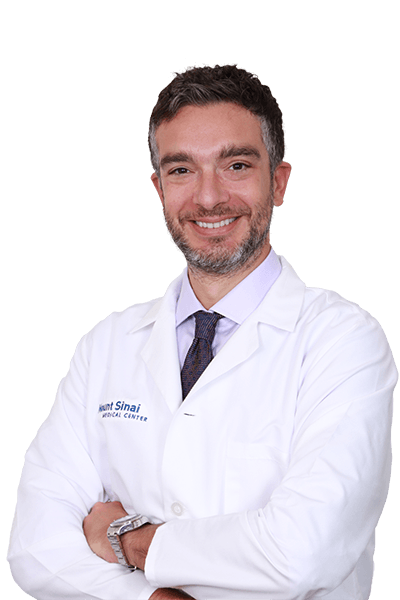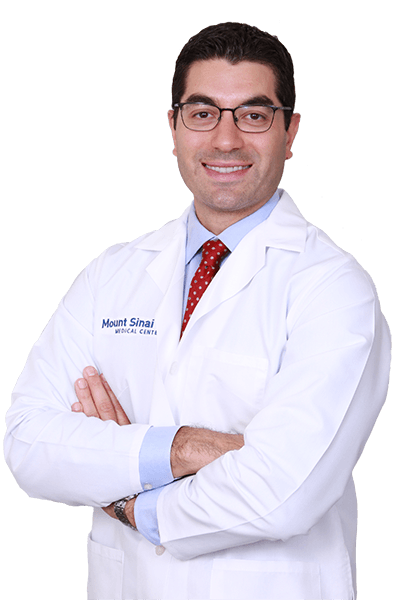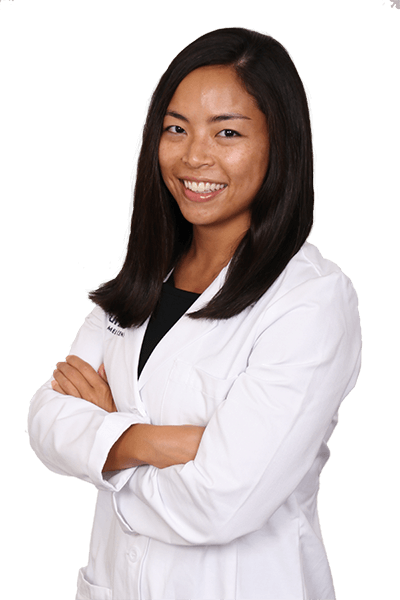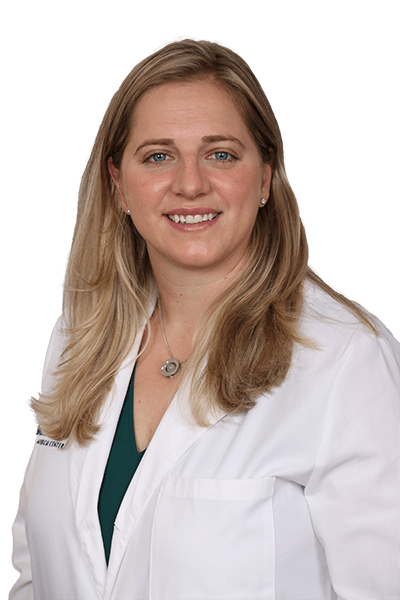Sports Medicine
From a casual game of tennis or one-on-one basketball, to competitive team sports and professional athletics, physical activity can cause a variety of injuries to your bones and other body parts. That’s why Mount Sinai Medical Center has developed a robust and comprehensive sports medicine program. Our fellowship-trained orthopedic specialists can diagnose and treat your sports-related injuries and conditions, often without invasive procedures. In cases where surgery is required, we use minimally invasive techniques to minimize pain, reduce the risk of infection, and speed recovery time. Patients come to Mount Sinai’s sports medicine program for a wide variety of conditions, including:
Acromioclavicular Joint Injuries
The acromioclavicular joint, or AC joint, is one of four joints in the shoulder. It connects the clavicle (collar bone) to another smaller bone in the shoulder called the scapula. The bones can become dislocated from the joint where they are not fitting together properly. This kind of injury can be extremely painful and creates a visible deformity. Fortunately, Mount Sinai’s orthopedists can often treat AC injuries without surgery or by immobilizing the bones using stitches and a graft.Bicep Tendon Injuries
Just like all muscles, your bicep connects to bones with tendons. These tendons can tear from an injury, like lifting a heavy object, or they can become inflamed or swollen from overuse. The bicep tendons at the shoulder are called proximal, and the tendons that connect the bicep to the elbow are called distal. Proximal biceps injuries cause pain at the front of the shoulder, while distal biceps injuries can cause a sudden pop and pain. Proximal biceps injuries can improve with rest and steroid injections. For distal biceps injuries, time-sensitive surgery may be necessary by a Mount Sinai orthopedic surgeon who will repair the tendons with a “button” and a screw. Then patients will need to go through a period of rehabilitation.Early Knee and Shoulder Osteoarthritis
When younger people experience joint pain in the knee or shoulder along with swelling, it is usually a sign of early arthritis. Fortunately, we can successfully treat early arthritis in the shoulder and knee with anti-inflammatory medications like ibuprofen, physical therapy, lifestyle modifications, and corticosteroid injections.Fractures
At Mount Sinai, we treat broken bones from sports injuries differently depending upon which bone breaks. Some fractures only require physical therapy, while others require surgery to reconnect the bone and make sure it doesn’t move in order to heal. This may require using metal plates and screws. Other fractures require a cast or other device to immobilize the bone. Fractures from sports injuries include the following:- Clavicle fractures
- Elbow fractures
- Foot and ankle fractures
- Fractures of the fingers/hand/wrist/forearm
- Hip fractures
- Leg fractures
- Shoulder and arm fractures (humerus, clavicle, glenoid, and scapular bones)
Knee ACL Injuries
The ACL, or anterior cruciate ligament, connects the thigh bone to the shin bone. ACL injuries are one of the most common knee ligament injuries in athletes. They typically don’t result from an impact, but instead when the knee “buckles.” Patients often describe hearing or feeling a “pop,” and then the knee becomes swollen and painful. At Mount Sinai, we almost always treat torn ACLs with surgery to reconstruct the damaged ligament.Knee Cartilage Defects
Defects in isolated areas of cartilage in the knee can happen as a result of a traumatic event like a sports injury, or from repetitive movements that “grind” down the cartilage. We treat these isolated defects differently than whole-knee arthritis. Instead, these isolated defects can be treated with special cartilage restoration surgeries.Knee Collateral Ligament Injuries (LCL/MCL)
The MCL, or medial collateral ligament, is the most commonly injured ligament in the knee. The injury happens when the knee gets bent inward. An MCL injury can happen by itself or can happen along with an ACL injury. If only the MCL is injured, surgery is rarely required. Instead, we use a knee brace and physical therapy. Injuries to the LCL, or lateral collateral ligament, happen when the knee is bent outward, usually from a direct blow to the inside of the knee. An LCL injury is a serious condition that often happens with knee ligament injuries. When multiple ligaments get injured, we call it “multiligament knee injuries,” and usually have to perform surgery to fix the injury.Knee Meniscal Injuries
The meniscus are two C-shaped structures in the knee that act as shock absorbers. Meniscal injuries are common in younger patients from playing sports. In older patients, we see meniscal injuries as a result of “wear and tear” or degeneration. Patients often experience sharp pain and knee mechanical symptoms such as “locking” or “clicking,” especially with squatting. Traumatic meniscal injuries often require surgery to repair the meniscus or remove the torn piece. Degenerative meniscal tears may respond well without the need for surgery.Knee PCL Injuries
The PCL, or posterior cruciate ligament, connects the thigh bone to the shin bone behind the knee. Injuries to the PCL can happen from a direct blow to the knee or from a hyperextension injury. More severe injuries may occur with knee dislocations. Isolated PCL injuries can be treated without surgery with physical therapy and bracing.Patella Instability and Dislocations
The patella is often referred to as the “knee cap.” It can become dislocated from trauma like a sports injury, or a patient may have anatomy that increases their risk of patella instability. If someone’s patella dislocates many times, it requires surgery to stabilize the patella.Quad Tendon Injuries
The quadriceps are located along the front of your thigh and help extend the knee. The quad tendons connect this large muscle to the thigh bone and the knee. Inflamed quad tendons often occur from jumping sports and usually cause pain and swelling just above the knee cap. If the quad tendon tears, we likely will need to perform surgery to repair the tendon.Rotator Cuff Tears
Tendons connect muscle to bones, and in the case of a rotator cuff, some or all of the tendons that stabilize and move the shoulder can tear. Small tears can be treated with physical therapy, but for larger tears, or when all of the tendons are torn, patients may require arthroscopic surgery.Shoulder Instability
An unstable shoulder can lead to a dislocation, a subluxation – which is a partial dislocation – or a feeling as if your shoulder is “slipping out of place.” At Mount Sinai, we typically treat shoulder instability with physical therapy; however, severe instability often requires surgery – either arthroscopic or open surgery – to repair the shoulder.Shoulder Labrum Tears
The labrum is a type of cartilage found in the shoulder joint. It helps keep the “ball” of the upper arm bone centered and aligned with the shoulder “socket.” Injuries to the labrum can happen if your shoulder dislocates, as well as from repetitive “micro” traumas. We often see labrum injuries to the back of the shoulder in linemen, weightlifters, and overhead athletes. When the labrum tears, we often need to repair it with surgery.Tennis Elbow and Golfer’s Elbow
These conditions affect either side of the elbow. Tennis elbow, or lateral epicondylitis, causes pain on the bony outside of the elbow. Golfer’s elbow, or medial epicondylitis, causes pain on the inside, folding part of the elbow. Both conditions are caused by damage to the tendons that connect the muscle to the bone and can result from overuse, small tears in the tendon, or an injury. Both conditions can cause mild to extreme pain and can make lifting and gripping difficult. Most patients tend to get better over a period of months; however, in some instances, your Mount Sinai orthopedist will recommend physical therapy.Our Physicians
Ettore Vulcano, MD
Chief, Division of Orthopedic Surgery
Director, Foot and Ankle Surgery
Associate Professor at the Columbia University Division of Orthopedic Surgery at Mount Sinai Medical Center
- Orthopedics
- Orthopedic Surgery
- Joint Replacement
- Foot and Ankle Surgery
- Mount Sinai Medical Center (Main Campus)
- 305.674.2090
- Mount Sinai Emergency Center, Physician Offices, Cancer Center and Diagnostic Center Aventura
- 305.674.2090
Karim Sabeh, MD
Director, Adult Reconstruction and Arthroplasty
Assistant Professor of Orthopedic Surgery at the Columbia University Division of Orthopedic Surgery at Mount Sinai Medical Center
- Orthopedics
- Orthopedic Surgery
- Hip & Knee
- Mount Sinai Medical Center (Main Campus)
- 305.674.2090
- Mount Sinai Emergency Center, Physician Offices, Cancer Center and Diagnostic Center Aventura
- 305.692.1080
Stephanie S. Shim, MD
Director, Hand and Upper Extremity Surgery
Assistant Professor at the Columbia University Division of Orthopedic Surgery at Mount Sinai Medical Center
- Orthopedics
- Hand Surgery
- Orthopedic Surgery
- Mount Sinai Medical Center (Main Campus)
- 305.674.2090
- Mount Sinai Emergency Center, Physician Offices, Cancer Center and Diagnostic Center Aventura
- 305.674.2090
Danica D. Vance, MD
Director, Sports Medicine
Assistant Professor at the Columbia University Division of Orthopedic Surgery at Mount Sinai Medical Center
- Orthopedics
- Sports Medicine
- Orthopedic Surgery
- Mount Sinai Medical Center (Main Campus)
- 305.674.2090
- Mount Sinai Emergency Center, Physician Offices, Cancer Center and Diagnostic Center Aventura
- 305.674.2090





